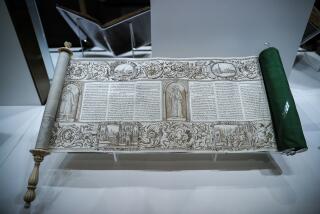Review: Three architects who built Jerusalem: How they shaped and fled (and were forgotten by) the conflicted city
All cities are cruel, but Jerusalem has a special way with heartbreak. In the evenings, the light is as soft as the local politics are rigid. Driving past the walls of the Old City at dusk, Jerusalem’s beauty can cause actual pain. For a moment you can almost forget the blood that spills, sometimes daily, outside Damascus Gate. But Jerusalem, Adina Hoffman writes, has an “almost chronic way … of frustrating hopeful expectation.” Like any place so old, it is built on its own ruins and on top of its dead, a city defined as much by what it has discarded and erased as by the conscious intentions of the people who currently reside there.
“This book,” Hoffman announces early in “Till We Have Built Jerusalem,” “is an excavation,” an attempt to sift the wreckage of Jerusalem’s buried past. Buried pasts, I should say — Hoffman makes it abundantly clear in this brave and often beautiful book that they are many — and interlinked. She digs through three of them, all by architects whose work shaped the city during its brief period of British colonial rule from 1922 until the establishment of the Israeli state and Jerusalem’s formal rupture into Arab east and Jewish west 26 years later.
Her subjects may be three now largely obscure builders — a German Jew, an Englishman and an Arab — but “Till We Have Built Jerusalem” is very much a book about the present. Hoffman, who has published one previous volume about the city and a highly acclaimed biography of the Palestinian poet Taha Muhammad Ali, writes with a quiet, stubborn courage, scouring the archives not only to understand Israel and Palestine as they exist today but to resurrect another vision, long since clouded over, in which identities were not so violently policed.
In the lost Jerusalem that Hoffman so skillfully and sorrowfully rebuilds, the permeability of boundaries — be they ethnic or aesthetic — was not a threat but a proud and defining characteristic of urban life.
A German Jewish builder
Erich Mendelsohn, Hoffman’s first subject of inquiry, was a rising star of Weimar Germany’s modernist avant garde who fled Berlin in 1934. He brought his wife, a few suitcases and enormous ambition, establishing his home and office in a stone building shaped like a windmill not far from where the Israeli prime minister’s residence now stands.
At the time, the local coins still read “Palestine”: it was then a colonial “mandate” whose administration had fallen to England when the European powers carved up the Ottoman empire after the First World War. Over the previous century Jerusalem had grown from a crumbling village of 8,000 to a sizable if still-sleepy town. Between 1917, the year Lord Arthur Balfour promised that the British crown would work for “the establishment in Palestine of a National Home for the Jewish people,” and 1934, when Mendelsohn arrived, the city’s population had more than doubled.
Much that now feels immutable was still up for grabs. The cosmopolitanism that had characterized late-Ottoman culture had not yet died. Older Jewish communities in Palestine spoke Arabic as well as Hebrew, and, in the early years of the mandate, Jews, Christians and Muslims intermingled freely. The notion endorsed by Balfour, of a Jewish state in Palestine, was far from unanimously supported even by Jews. The novelist and journalist Joseph Roth, whose peripatetic, open spirit Hoffman hails in her introduction, wrote in 1920 that “Zionism can only be a bitter experiment, a temporary, opportune degradation of Judaism,” words that today would make an outcast of him.
Yet Mendelsohn had arrived full of zeal, dreaming that he would be anointed master builder for all of Palestine. If he was arrogant, he did not lack in vision or in scorn for his colleagues in Tel Aviv whose Bauhaus-influenced structures seemed intended for a sunnier Vienna. Palestine, Mendelsohn wrote, “is in the Orient, of the Orient,” and demanded an architecture appropriate to its culture and climate.
Mendelsohn’s Zionism was enthusiastic, almost ecstatic: The return of Jews to Palestine was an opportunity for a spiritual renaissance that might flow from Jerusalem to the rest of the world. But for all his rhapsodies about “the true soil desired by my blood and my nature,” Mendelsohn was also cognizant that Palestine was not a blank slate for diasporic rebirth, that real people lived there, people who had a valuable architectural tradition of their own. He admired the layout of even the poorest Palestinian homes and villages, the respect they showed to climate and terrain.
This was not a popular perspective, and it grew less so as attitudes hardened. Mendelsohn built a home for the Zionist leader Chaim Weizmann, an elegant villa and library for the publishing magnate Salman Schocken, the headquarters of the Anglo-Palestine Bank, and the hospital that still stands on Mt. Scopus. But his grand design for the campus of Hebrew University, which he hoped would become the beacon of a “vital, secular Hebrew culture,” was rejected. By the late 1930s his style — spare, streamlined structures, open to the landscape that surrounded them — had aroused “violent and widespread opposition,” in the words of Judah Magnes, the university’s first chancellor.
Sometimes that violence was literal. Hoffman writes of gangs allegiant to Ze’ev Jabotinsky — the ideological father of the Revisionist politics that live on in Benjamin Netanyahu — attacking Mendelsohn’s construction sites because the laborers he hired hailed from the socialist left.
By the time the architect left Jerusalem in 1941 — for New York and later San Francisco — a Palestinian uprising against British rule had been brutally put down, Jewish militias were planting bombs in Arab markets and buses, and Mussolini’s air force was strafing Tel Aviv. In that atmosphere, Mendelsohn had published a pamphlet suggesting that Zionism must not only accommodate but unite with the population already present in Palestine. He called on Jews to “become a cell” of a “future Semitic commonwealth” modeled on the medieval golden age of Arab rule, when Jews and Arabs together acted as “torchbearers of world enlightenment.” The pamphlet was, Hoffman writes, a “cri de broken coeur,” one that Mendelsohn must have known came far too late to win him anything but ridicule.
Mendelsohn left Jerusalem embittered and defeated. The arc Hoffman describes here diverges sharply from the usual heroic narratives of Israel’s founding. These are stories of possibilities closing off, prejudices ossifying, diverse and vibrant communities destroyed.
The British aesthete
Austen St. Barbe Harrison, Hoffman’s second subject, decamped from Jerusalem in an even greater hurry in 1937, 15 years and one day after his arrival, precisely the time required to claim his government pension. The official chief architect of Palestine under the British Mandate, Harrison was not as ill-regarded as Mendelsohn at the time of his departure, but he nonetheless left in secret, abandoning most of his possessions. He could not, apparently, get out soon enough.
A curious, solitary soul, “essentially, evenly implacably British” but more at home in his modest house in Abu Tor than he ever had been in England, Harrison designed most of the public buildings that the British left behind in Palestine. Hoffman writes admiringly of “the logic, restraint, and complex placidity” of his creations, which showed “the outlines of a modest Palestinian peasant house fused with contours far grander and stranger.” She displays a deep respect for his obsessive attention to the details of his craft, which is not surprising, given the careful agility and precision of her own prose.
Beyond that, it is the frustration and heartbreak that seem to reach out to her across the decades. Harrison was much more an aesthete than a politician and did his quiet best to navigate the increasingly treacherous waters in which he was required to work. Hoffman sees in the “bright calm” of the atrium of the archaeology museum that Harrison designed in the mid-1930s a “bottled-up, unspoken desire for the strife to just stop, or at least to subside temporarily.”
It did not, of course. The museum’s opening ceremony in 1938 was canceled after a noted English archaeologist was killed by Palestinians in what is now the southern West Bank. By then Harrison was already gone. He missed the opening too for the grand central post office on Jaffa Street, his last major project in the region. One year later, it would be bombed by the Irgun, a right-wing Jewish militia that would eventually be folded in to the Israeli army.
The lost Sypro Houris
It is in her third and final section that Hoffman’s quest begins to feel truly urgent. This is in part because of timing. Her research on the elusive architect Spyro Houris took place in summer 2014, when in the weeks that followed the kidnapping and murder of three Israeli teens, mobs of young Israelis marched through the streets of Jerusalem chanting “death to Arabs,” a Palestinian teenager was burned alive, and clashes raged night after night across nearly all of East Jerusalem. By the end of that August, 72 Israelis and more than 2,200 Palestinians had been killed.
With Mendelsohn and Harrison, Hoffman found abundant archives to draw on: official records, letters, memoirs. But Houris, who left behind at least a dozen buildings decorated with colorful Armenian tile in neighborhoods across the city, was an Arab, and hence a ghost. The history of nearly all private structures “erected by anyone who wasn’t Jewish,” Hoffman found, had vanished into an “archival black hole.”
The search is like a detective story, filled with dead-end plotlines and gripping diversions that get her no closer to her quarry. Eventually, she discovers a few bare biographical details.
She digs as far as she can into the histories of Houris’ buildings in the Greek Colony, on Jaffa Street and in Mamilla, which was then a mixed neighborhood and is now the site of a shopping mall just outside of which the Simon Wiesenthal Center is building a Museum of Tolerance atop the oldest Muslim graveyard in the city.
Frustrated in her obsession, Hoffman writes about some of his contemporaries: the Palestinian intellectual Khalil al-Sakakini, who lived in the stone windmill where the Mendelsohns would later take up residence; about the master ceramist David Ohannessian, who fled the Armenian genocide and was brought to Jerusalem to retile the dome of the al-Aqsa mosque; about C.R. Ashbee, a central figure of the British Arts and Crafts movement who left Jerusalem, disillusioned and embittered, in 1922.
And then there are the patrons for whom Houris built: a Greek Christian, a Turkish Jew and one of the most prominent Muslim families in Jerusalem. Through them, she ends up describing two cities, the contemporary Jerusalem in which she lives, walled off and pushed by a “willful forgetting” into an unending violent spiral, and the lost metropolis that Houris inhabited, defined by a radical eclecticism and a now almost inconceivable openness to its past and the expansive possibilities of its various selves.
“All I can do is dig, and keep digging,” Hoffman writes, almost desperately. She was consciously searching, via Houris, for clues to what Jerusalem had lost, “some sense of itself as a place more multitudinous, more heterogeneous, more generous” than the one in which she found herself. We are fortunate that she did, that she found the strength to remind us that other possibilities have existed, and may yet exist, beside the current grim reality.
Ehrenreich is the author of the novels “Ether” and “The Suitors.” “The Way to the Spring,” based on his reporting from the West Bank, will be published by Penguin Press in June.
::
“Till We Have Built Jerusalem”
Architects of a New City
Adina Hoffman
Farrar, Straus and Giroux: 368 pp., $28
More to Read
Sign up for our Book Club newsletter
Get the latest news, events and more from the Los Angeles Times Book Club, and help us get L.A. reading and talking.
You may occasionally receive promotional content from the Los Angeles Times.






